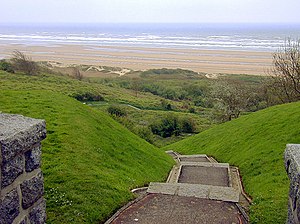Operation Aquatint
| Operation Aquatint | |||||||
|---|---|---|---|---|---|---|---|
| Part of North West Europe Campaign | |||||||
 Omaha beach |
|||||||
|
|||||||
| Belligerents | |||||||
|
|
|
||||||
| Commanders and leaders | |||||||
|
|
|
||||||
| Strength | |||||||
| 10 British Commandos 1 Free Frenchman 1 Motor Torpedo Boat |
320th Infantry Division | ||||||
| Casualties and losses | |||||||
| 3 killed in action 1 killed in captivity 2 fate unknown 5 captured and survived |
Unknown | ||||||
Operation Aquatint was the codename for a failed raid by British Commandos on the coast of occupied France during the Second World War. The raid was undertaken in September 1942 on part of what later became Omaha Beach by No. 62 Commando, also known as the Small Scale Raiding Force.
Prior to the operation, a raid on the French coastal town of Dieppe had placed the German occupying forces on a high state of alert, and this ultimately contributed to Aquatint's failure. The commandos were also unable to identify their correct landing place due to the darkness. Within minutes of landing, the raiding party was ambushed by a German patrol and forced to try to reach their Motor Torpedo Boat (MTB) transport. The MTB was located and engaged by the German shore batteries, which damaged one of its engines. It was forced to withdraw, leaving the commandos behind. At the end of the raid those commandos who had not been killed all became prisoners of war. Only five of the raiding force would survive the war; one was killed in captivity and the fate of the other two is uncertain.
Following a request from the Chief of Combined Operations Admiral Louis Mountbatten for probes of German coastal defences, No. 62 Commando, also known as the Small Scale Raiding Force (SSRF), mounted a number of operations in 1942. The first three missions were complete successes: Operation Barricade (14/15 August 1942), Operation Dryad, (2/3 September 1942), and Operation Pound (7/8 September 1942). Aquatint was planned for a night in mid September 1942 as a reconnaissance mission near Sainte-Honorine-des-Pertes, a small coastal town near Port en Bessin in Normandy. The mission was to collect information about the surrounding area, and take a German guard prisoner. Aerial reconnaissance had identified a small group of houses on the seafront thought to be occupied by Germans.
...
Wikipedia
